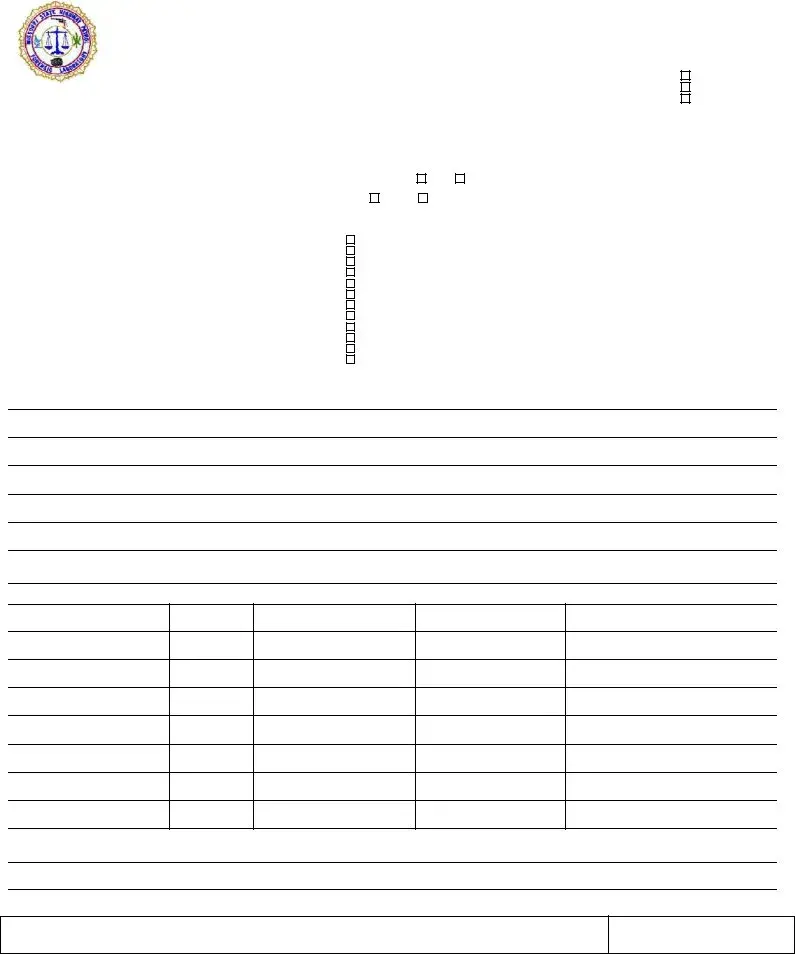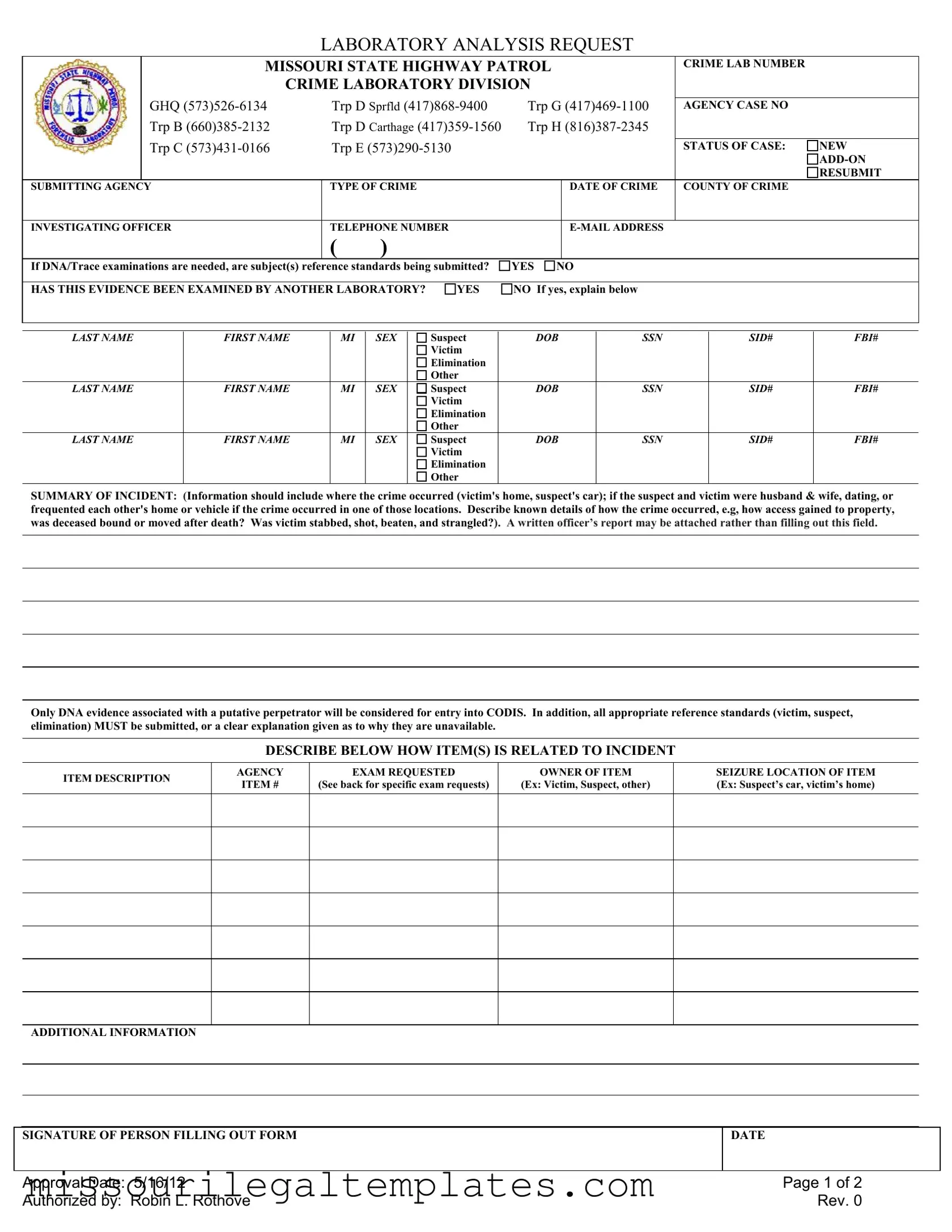
LABORATORY ANALYSIS REQUEST
|
|
MISSOURI STATE HIGHWAY PATROL |
|
|
CRIME LAB NUMBER |
|
|
|
CRIME LABORATORY DIVISION |
|
|
|
|
|
|
|
|
|
|
|
|
|
|
|
|
|
|
|
|
GHQ (573)526-6134 |
|
Trp D Sprfld (417)868-9400 |
Trp G (417)469-1100 |
AGENCY CASE NO |
|
|
Trp B (660)385-2132 |
|
Trp D Carthage (417)359-1560 |
Trp H (816)387-2345 |
|
|
|
|
|
|
|
|
|
|
|
|
|
|
|
|
|
|
Trp C (573)431-0166 |
|
Trp E (573)290-5130 |
|
|
|
STATUS OF CASE: |
NEW |
|
|
|
|
|
|
|
|
|
|
|
|
|
|
ADD-ON |
|
|
|
|
|
|
|
|
|
|
|
|
|
|
RESUBMIT |
SUBMITTING AGENCY |
|
TYPE OF CRIME |
|
|
|
DATE OF CRIME |
COUNTY OF CRIME |
|
|
|
|
|
|
|
|
|
|
|
|
|
|
INVESTIGATING OFFICER |
|
TELEPHONE NUMBER |
|
E-MAIL ADDRESS |
|
|
|
|
|
|
( |
) |
|
|
|
|
|
|
|
|
|
If DNA/Trace examinations are needed, are subject(s) reference standards being submitted? |
YES NO |
|
|
|
|
|
|
|
|
|
|
|
|
|
|
|
HAS THIS EVIDENCE BEEN EXAMINED BY ANOTHER LABORATORY? |
YES |
NO If yes, explain below |
|
|
|
|
|
|
|
|
|
|
|
|
|
|
|
|
|
|
|
|
|
|
|
|
|
|
|
|
|
|
|
|
|
LAST NAME |
|
FIRST NAME |
|
MI |
SEX |
|
Suspect |
|
DOB |
|
SSN |
|
SID# |
FBI# |
|
|
|
|
|
|
|
Victim |
|
|
|
|
|
|
|
|
|
|
|
|
|
|
Elimination |
|
|
|
|
|
|
|
|
|
|
|
|
|
|
Other |
|
|
|
|
|
|
|
LAST NAME |
|
FIRST NAME |
|
MI |
SEX |
|
Suspect |
|
DOB |
|
SSN |
|
SID# |
FBI# |
|
|
|
|
|
|
|
Victim |
|
|
|
|
|
|
|
|
|
|
|
|
|
|
Elimination |
|
|
|
|
|
|
|
|
|
|
|
|
|
|
Other |
|
|
|
|
|
|
|
LAST NAME |
|
FIRST NAME |
|
MI |
SEX |
|
Suspect |
|
DOB |
|
SSN |
|
SID# |
FBI# |
|
|
|
|
|
|
|
Victim |
|
|
|
|
|
|
|
|
|
|
|
|
|
|
Elimination |
|
|
|
|
|
|
|
|
|
|
|
|
|
|
Other |
|
|
|
|
|
|
|
SUMMARY OF INCIDENT: (Information should include where the crime occurred (victim's home, suspect's car); if the suspect and victim were husband & wife, dating, or frequented each other's home or vehicle if the crime occurred in one of those locations. Describe known details of how the crime occurred, e.g, how access gained to property, was deceased bound or moved after death? Was victim stabbed, shot, beaten, and strangled?). A written officer’s report may be attached rather than filling out this field.
Only DNA evidence associated with a putative perpetrator will be considered for entry into CODIS. In addition, all appropriate reference standards (victim, suspect, elimination) MUST be submitted, or a clear explanation given as to why they are unavailable.
DESCRIBE BELOW HOW ITEM(S) IS RELATED TO INCIDENT
EXAM REQUESTED
(See back for specific exam requests)
OWNER OF ITEM
(Ex: Victim, Suspect, other)
SEIZURE LOCATION OF ITEM (Ex: Suspect’s car, victim’s home)
ADDITIONAL INFORMATION
SIGNATURE OF PERSON FILLING OUT FORM
Approval Date: |
5/16/12 |
Page 1 of 2 |
Authorized by: |
Robin L. Rothove |
Rev. 0 |
LABORATORY ANALYSIS REQUEST
EXAM REQUESTS
DNA Exams
1.DNA Analysis --for sexual assault kits, buccal swabs, swabs from item at crime scenes, or clothing that needs tested for non- stain DNA such as hats, masks or gloves.
2.Blood Detection (for DNA)--for items that are to be examined for the presence of blood that will be tested for DNA.
3.Semen Detection (for DNA)--for items that are to be examined for the presence of semen that will be tested for DNA.
Drug Chemistry
1.Marihuana Analysis--for items that are suspected of being or containing marihuana.
2.Drug Analysis--for items suspected of being or containing controlled substances, but not including marihuana.
Firearm/Toolmark
1.Firearm/Ammunition Examination--for firearm examinations and comparisons of ammunition components.
2.Tool Mark Examinations--for comparing tools to toolmarks.
3.Serial Number Restoration--for items with defaced serial numbers that are to be restored.
4.Impression (tire/footwear examination) -- for examination of tire/footwear impressions.
5.Shooting Distance -- for items such as clothing that need to be analyzed for muzzle-to-target distance determination. This exam involves clothing with a suspect bullet hole.
Latent Prints
1.Latent Print Processing--for evidentiary items to be processed to develop latent prints. Latent comparisons and/or AFIS entry are assumed if latent prints of value are developed.
2.Latent Print Comparison--for comparisons of latent prints developed at the scene with known exemplars. AFIS entry is assumed if manual comparisons with known exemplars yield negative results or if there are no known subjects listed.
3.AFIS Entry-- for latent prints to be searched through the AFIS database. This is to be selected only at GHQ lab by agencies who employ latent print examiners to conduct manual verification of AFIS results.
4.Postmortem Identification -- for comparisons and/or AFIS entry of postmortem prints.
Toxicology
1.Blood Alcohol Analysis--to determine alcohol content in blood samples.
2.Urine Drug Analysis--for urine samples to be analyzed for drugs.
3.Blood Drug Analysis--for blood samples to be analyzed for drugs.
4.Blood Carbon Monoxide Analysis--for blood samples to be analyzed for carbon monoxide.
5.Foreign Substance (food/drink-poison)--for blood, urine, stomach contents, etc to be analyzed for drugs or other poisonous or harmful substances.
6.Alcoholic Beverage Analysis--to determine alcohol content in commercial products.
Trace Evidence
1.Explosives analysis--for pre-blast and post-blast items or suspected explosives.
2.Filament (on/off for vehicle accidents)--for lamps from automobiles and boats to determine if on or off at time of accident.
3.Flammable (fire investigation)--for identification of flammable liquids or the presence of flammable liquid residues on fire debris.
4.Fracture Match (broken/torn)--for broken or torn items to determine if originally one piece.
5.Glass (processing/analysis)--for the detection, collection or comparison of glass standards and questioned glass particles from shoes, clothes or other sources.
6.Gunshot Residue Kit Analysis--for kits taken from hands or other surfaces. Kits taken from shooting victims will not typically be analyzed.
7.Gunshot Residue (Except kits)--for items such as clothing that need to be sampled for the presence of gunshot residue. Clothing is typically limited to gloves and long sleeve shirts and jackets.
8.Hair/Fiber (Trace exams only)--for the detection, collection or comparison of hairs, fiber standards, and fibers from shoes, clothes or other sources. DNA exams will be performed on hair if possible or necessary.
9.Hair (with DNA)--for items that contain hair or are to be examined for the presence of hair that have been submitted with other items needing DNA exams.
10.Paint Analysis--for the comparison of paint standards and transfers.
11.Physical Characteristics Comparison--for comparison of items such as tape, wood, plastics and other miscellaneous materials.
12.Soil (collect/compare)--for the detection, collection or comparison of soil standards and questioned soil samples from shoes, clothes or other sources.
13.Substance ID (unknown/tampering)--for substances suspected of being harmful or causing property damage that may be found in food, mail or on damaged property
Approval Date: |
5/16/12 |
Page 2 of 2 |
Authorized by: |
Robin L. Rothove |
Rev. 0 |

